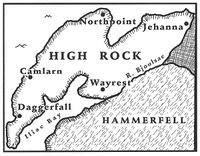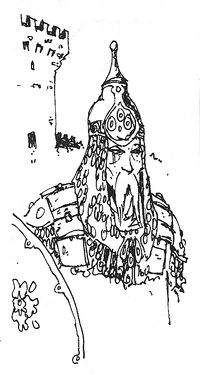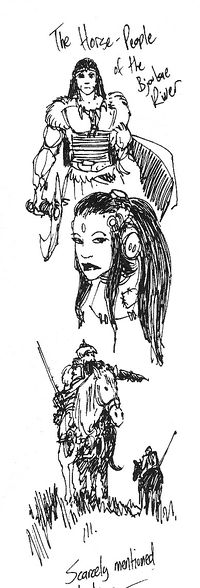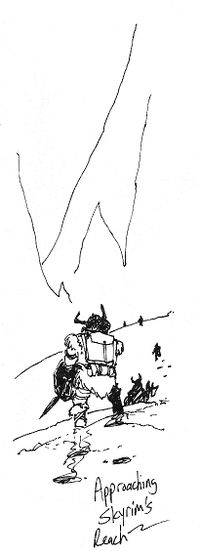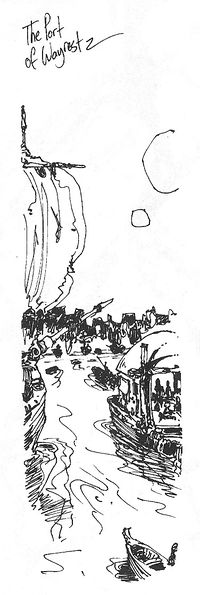Lore:Pocket Guide to the Empire, 1st Edition/High Rock
The UESPWiki – Your source for The Elder Scrolls since 1995
| HIGH ROCK |
- High Rock encompasses Greater Bretony, the Dellese Isles, the Bjoulsae River tribes, and, by tradition, the Western Reach. Its various peoples are called Bretons for the sake of convenience only, as the endless multitude of city-states, principalities, baronies, duchies, and kingdoms that make up High Rock has, until recently, resisted all attempts at centralization into a single culture or government. The Nords of the First Empire never conquered the whole of High Rock; the Cyrodiils ruled it, but failed to stamp out its virulent sectarianism, which sprang up again with renewed fury during the Interregnum. It is only now, under the guidance of the Third Empire, that High Rock is finally tasting the fruits of peace and unity, although a few Bretons still chafe under Tiber Septim's firm hand. Aside from Imperial rule, Bretons are connected only in their language, geographic location, and the ancient rift that separated them from their Nordic progenitors, the Night of Tears.
- Khosey, in his 'Tamrilean Tractates,' transcribes a firsthand account of the "discovery" of the Bretons by a Nordic hunting party. The Bretons, in ten generations of Elven intermingling and slavery, had become scarcely recognizable as humans. Indeed, the hunting party attacked them thinking they were some new strain of Aldmeri, halting their slaughter only when one of the oldest began to wail for his life, a shrieking plea that was spoken in broken Nordic. When word of this reached Windhelm, the Nords reasoned that the "Manmeri" beyond the Reach were, in fact, descended from human slaves taken during the Elven destruction of Saarthal. King Vrage made the first priority of his Empire the liberation of his long-tormented kinsmen in High Rock. His initial onslaught took him as far as the Bjoulsae, but beyond that the First Empire never established a lasting presence; the crafty Elves were too strong in their magic, and many of the Bretons aided the Elves against their would-be liberators. Ironically enough, it took the tyranny of the Alessian Order to finally free High Rock from Elven dominion. Although the Alessians were crushed at the Battle of Glenumbria Moors, this costly victory so weakened Aldmeri power that the Elves could no longer challenge the emerging nobility of Greater Bretony, who seized power throughout most of High Rock within two decades of the Alessian defeat.
- This rebellion was not a coordinated effort, however, and while most of High Rock was freed from Elven tyranny by 1E500, parts of the province remained under Elven rule for much longer. The Western Reach, paradoxically, was one of the last bastions of the Aldmeri in High Rock, the legacy of which is still apparent today (see below). Bretons have fought on both sides of most of the great conflicts of Tamrielic history, including Glenumbria Moors; the memories of these victories and defeats continues to taint relations between the many factions of this divided people. The burghers of Anticlere, for instance, still noisily commemorate the Battle of Duncreigh Bridge, the "famous victory" of their Duke over the neighboring hamlet of Sensford in 1E 1427 (a battle which apparently achieved nothing, as each village continues to boast its own ruling family of antique lineage), by marching each year down Sensford's main street, a progress that results in numerous injuries on both sides even when it does not provoke a brief war between the "knightly orders" of the two villages.
- Today, the social structure of the Bretons has divided itself into a poor middle class and destitute peasantry, a magical elite separate from their squalor, and an often incoherent jumble of nobility and ruling families above them all. It is beyond the small ambition of this pamphlet to address the latter in any better terms, for even the natives have difficulty distinguishing their leaders from one another. Indeed, it is an old joke among the Bretons: "find a new hill, become a king," and many have taken it to heart. Youths of all professions and trades in High Rock spend their free time in knightly pursuits, real and imagined, performing good deeds and the like for all and sundry, in oft-vain efforts to achieve, one day, a noble status. This "quest-obsession," more than anything, has served as High Rock's sense of national identity, a peculiar form of altruism and mutual reliance that binds its people together.
- The geography of High Rock is as varied as its people. The forested peaks of the Wrothgarian Mountains, occupied only by herders and the occasional dismal hamlet, divide the Western Reach from more heavily settled west of High Rock. The only true cities lie along the Iliac Bay, where several small kingdoms prospered from the trade that flowed through the Bay to the Bjoulsae River. Inland, the land rises to the windswept plateau of North Kambria, with many small towns tucked into the folds and valleys that wind their way down to the northern coast. This bucolic landscape is marred by the grim fortifications that perch atop every hill and crag, a reminder of the constant warfare that has been the scourge of the province. In the past, each petty lord, secure in his castle, enriched himself with tribute from all who traversed his domain, a circumstance clearly incompatible with the free flow of commerce. Now Tiber Septim has begun a program of demolition of these myriad fortresses, a wise policy that should facilitate prosperity while removing a potential refuge for subversives.
- Although the Bretons are divided into numerous mutually antagonistic factions, to the outsider a singular uniformity in dress, architecture, and customs prevails throughout the land. Bretons are not an imaginative people, a legacy of the Elves, perhaps, and traditional ways are not lightly abandoned. Their villages are pleasant collections of half-timbered structures of one or two stories, with the rustic inn, a shop or two, and perhaps a lordly manor completing the picture. The traveler need not visit more than a handful of Breton communities before satisfying himself that he has captured the flavor of the whole. The people, too, despite their cherished particularism, are remarkably similar in name, accent, and dress throughout the province. It may be that this unacknowledged homogeneity bodes well for the future harmony of High Rock.
- Most Bretons share an affinity for magic wrought, no doubt, by their lamentable intermingling with the Elves. This talent manifests itself in High Rock's pocket cultures in various ways. In the richer, more urban centers of the Iliac Bay, it has been systematically organized along the hierarchical lines of the Mages Guild. Children are tested for their magical potential at an early age, and those who pass enter apprenticeship programs funded by the Guild itself, or through independent sponsorship. In more remote regions, such as Glenpoint and the Wrothgarian Mountains, witches and medicine men, barely distinguishable from Orcish shamans, hold sway over the superstitious peasants with feats of untutored, but often impressive, magical ability.
Places of Note:
- Daggerfall
- One of the oldest and largest cities of High Rock, Daggerfall has long considered itself the capital of High Rock, by virtue of its antiquity, prominence, and prosperity. All three of these qualifications may seem fanciful to the outsider, in comparison to Cyrodiil, Windhelm, or even Sentinel across the Iliac Bay. But Daggerfall was one of the largest kingdoms in High Rock before its accession to the Empire, and retains the right to maintain its royal court according to Cyrodilic tradition. Although few buildings of any age survive, Bretons being unsentimental about their history, Daggerfall is of considerable antiquity, founded originally by the Nords as a coastal foothold during the heyday of the First Empire. The city's fortunes have waxed and waned over the years; during the Alessian period it was of considerable importance, but it suffered greatly in the Thrassian Plague and is only now beginning to recover. The rise of Wayrest has lessened Daggerfall's importance as a trading port, although it should benefit from the opening of trade with the interior of the province.
- Wayrest
- Wayrest has always seen itself as the rival of Daggerfall, but continues to suffer from an inferiority complex that is evident in the ostentatious display of its ruling house. Daggerfall was already a well-established kingdom when Wayrest was merely a collection of rude huts at the mouth of the Bjoulsae River. But Wayrest prospered mightily after the Fall of Orsinium when the commerce from the whole of Tamriel began to flow past its gates, and today it boasts the largest and richest population in High Rock. The merchants of Wayrest have welcomed the arrival of the Empire, particularly the Navy's Northwest Fleet, which has made suppression of the notorious pirates of the Iliac Bay its top priority.
- Isle of Balfiera
- This island in the Iliac Bay has been used for centuries as a neutral meeting place for diplomatic negotiations and treaty signings by the kingdoms of High Rock. It is also famous for the enigmatic structure known as Adamantine Tower, a circular tower soaring hundreds of feet into the sky. The traditional ruler of the island is known as the Castellan of Balfiera, perhaps reflecting his original role as commander of Direnni (or Balfiera) Tower, which was used as a fortress, prison, and palace by the infamous Direnni Hegemony. Even more curiously, the hereditary Castellans are High Elves, the only known Elven ruling family remaining in human lands. The Castellans continue to reside in the Tower, although its true provenance and purpose remains a mystery. A recent archaelogical study, using the latest techniques of divination and sorcery, has pushed the Tower's construction date back to around ME2500, making it by far the oldest known structure in Tamriel. Although it has been much modified and added on to over the years, its core is a smooth cylinder of shining metal; the Tower is believed to extend at least as far beneath the surface as is now visible above, although its deepest bowels have never been systematically explored.
- The Western Reach
- The Western Reach is actually the easternmost section of the Breton lands; its name derives from its location on Skyrim's western border. During the First Empire, it was incorporated as one of the Holds of Skyrim, and many Nords settled in its rolling hills and pleasant valleys. But they paid a terrible price during the Dissolution of Skyrim's Empire; the Aldmeri retook the Western Reach with a vengeance, slaughtering the Nord colonists to a man; precious little Nord blood flows in the veins of today's Reachmen. As a hedge against future incursions from Skyrim, the Aldmeri fashioned the Western Reach into an impregnable bastion. Thus, the Western Reach remained under Elven rule the longest of any part of High Rock, and the legacy of this dark sojourn can still be seen today.
- The Reachmen are a mongrel breed, even for Bretons. Descended originally from one of the earliest Atmoran tribes to settle Tamriel, their lineage now partakes of nearly every race imaginable. The uprising that finally "freed" the Western Reach ended in the extermination of the Aldmeri overlords, but Elven blood still flows strong in the Reachmen, and they share the secretive, haughty demeanor of that race. In later years, they traded and exchanged customs with the Orcish villages that shared their mountains, and eventually learned much of the beastfolk's magic. Reach-magic is still widely studied, although it is banned by the Mages Guild (who fear it as dangerous and wild hedge-wizardry), and the Reachmen are often referred to as the "Witchmen of High Rock."
- Banditry and lawlessness continue to plague the region, and it remains under the direct rule of Provisional Governor Titus Alorius[nb 1] . Travelers are advised to avoid this region until the present disturbances are quelled-- a state of affairs, however, that is likely soon to be rectified. The benefits of membership in the Empire are so patent, and the resistance of the rebellious Reachmen so futile, that it is to be expected that the Western Reach will soon join the rest of High Rock in the new era of peace and prosperity wrought by the tireless efforts of Tiber Septim and his loyal companions. We can only hope that this comes to pass without further useless effusion of blood.
